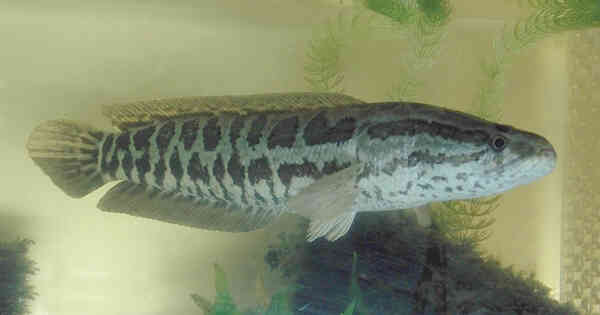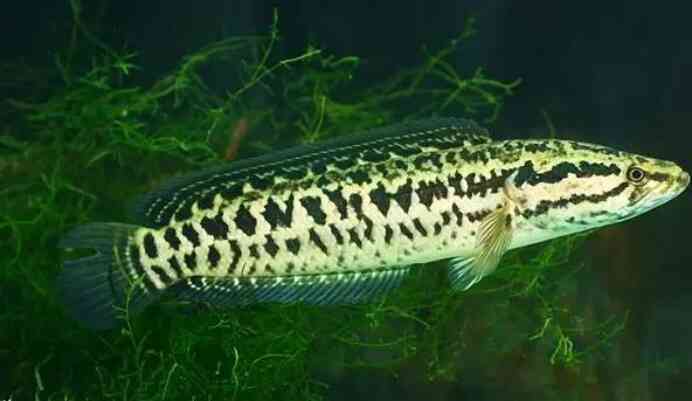The snakehead is a bottom-dwelling carnivorous and ferocious fish. It usually likes to live in shallow waters with dense aquatic plants along the coast. It lurks in the aquatic plants and waits for the opportunity to hunt for food. Sometimes it swims in the upper layer of the water at night. The fry feed on zooplankton; the young fish feed on aquatic insects, shrimps and small fish; the adults prey on other fish. The snakehead likes to rest on the bottom of water with dense aquatic plants or turbid water. When small fish and shrimps swim close, it will launch a surprise attack and swallow these small animals. A 0.5 kg snakehead can swallow a 150 gram grass carp or carp. The snakehead can also directly absorb oxygen from the air. With this "special ability", when there is no rain for a long time and the lake is about to dry up, it can hibernate like some animals. At this time, it sits in the mud with its tail down, leaving only its mouth above the mud surface. This is commonly known as the snakehead "sitting" or "escape", which is the snakehead's "dry sleep". At this time, it is in a numb state, which can last for several weeks, and it will resume normal life when water comes again. It burrows into the mud during hibernation. In warm seasons, after the snakehead has been active in the water for a period of time, it often needs to expose its head above the water to assist breathing.

The snakehead is a ferocious carnivorous fish and is quite greedy. The prey varies with the size of the fish. The main food of seedlings under 3 cm in length is copepods, cladocerans and chironomid larvae, while the main food of seedlings under 3-8 cm in length is aquatic insect larvae, tadpoles, shrimps and fry, while the main food of commercial fish over 20 cm in length is various small fish and frogs (small fish mainly refer to crucian carp, mullet, red-eyed trout, loach and various young fish). The black snakehead swims slowly, but it generally does not chase its prey when hunting. Instead, it hides near aquatic plants or other shelters and pays close attention to the surrounding movements. Once it finds fish or other palatable live bait swimming nearby, it will quickly attack and capture it in one fell swoop. The black snakehead has a large food intake and can often swallow live bait that is about half of its body length. The maximum capacity of its stomach can reach about 60% of its body weight. According to dissection, a 500-gram black snakehead swallowed 8 10-cm-long grass carp in a short period of time. The black snakehead also has the habit of killing each other, and can swallow individuals of the same species that are less than 2/3 of its own length. The amount of food it eats is closely related to the water temperature. In summer, when the water temperature is high, it is quite greedy and eats a lot; when the water temperature is below 12℃, it stops eating. Under artificial breeding conditions, when animal feed is insufficient, it can also feed on artificial compound feed such as bean cake, vegetable cake, and fish meal.
The black snakehead has a strong adaptability to changes in environmental factors in the water body, especially to hypoxia, water temperature and poor water quality. When the water body is hypoxic, it can occasionally expose its head to the surface of the water. With the help of the suprabranchial organ composed of bone pieces extending from the upper branchial bone and the lingual maxilla on the back of the first branchial arch in the gill cavity, it directly breathes oxygen in the air. Therefore, it can survive for quite a long time even in wet areas with little or no water. The survival water temperature of mullet is 0-41℃, and the optimum water temperature is 16-30℃. When the water temperature reaches above 8℃ in spring, it often moves in the middle and upper layers of the water body; in summer, it moves in the upper layer of the water body; when the water temperature drops below 6℃ in autumn, it swims slowly and often lurks in the deep water; when the water temperature approaches 0℃ in winter, it hibernates in the mud at the bottom of the water and stops eating.
Black snakehead has a strong jumping ability. When the weather is hot and humid, and the water rises due to rain, mullet often jumps out of the water and escapes along the pond bank; when there is a flow of water, it will also cause the fish to jump and escape. If the pond where it lives is short of food, it will also move to another pond. When moving, its body is like a snake, moving forward slowly.
Black snakehead grows rapidly. Due to the different growth environments of the fish, individual differences are very large. Generally, the young fish hatched in the same year can reach an average body length of 15 cm and a weight of about 50 grams by the end of the year. According to the measurements of black snakehead collected by the Yangtze River Fisheries Research Institute in Taihu Lake, the body length and weight of each age group are: 1 Winter fish body length 14.2-19.2 cm, weight 115-428 grams; 2 Winter fish body length 24.0-28.0 cm, weight 350-760 grams; 3 Winter fish body length 32.9-38.0 cm, weight 600-1000 grams. Among the catches, most weigh about 500 grams, and the largest individual can reach 5,000 grams. The growth rate of the black snakehead is quite fast, but the growth rate of the black snakehead and the spotted snakehead is different in different regions and environments.

Black snakehead can be eaten, but it is harmful to the fish farming industry. Black snakehead meat contains protein, fat, multiple amino acids, and also contains essential minerals and multiple vitamins for the human body. Its fish meat is tender and thick, and is usually processed into fish segments or fish fillets before cooking. In natural waters, the snakehead mainly eats small fish. It is ferocious and has a huge appetite, often eating all other fish in a lake or pond. Artificial breeding must be carried out in the wild.
The snakehead is large, grows fast, and has high economic value. Because the supragillary organs can withstand low oxygen, this fish is easy to transport. In addition to fishing in natural waters, it should also be raised in different areas. In reservoirs where silver carp, bighead carp, and grass carp are not raised, snakehead should be protected for reproduction, and the fishing of adult fish should be appropriately strengthened to increase production.
The protein content of snakehead fish is 18.8-19.8%, the fat content is 0.8-1.4%, the moisture content is 77.9-80%, and the ash content is 1.1-1.2%. Zinc is 36.1 mg/kg. Snakehead fish has few bone spurs, high meat content, and rich nutrition, with higher protein content than chicken and beef. Snakehead fish has the effects of removing blood stasis, promoting new blood, nourishing and conditioning as a medicine. After surgery, eating snakehead fish has the effects of promoting muscle growth and blood, and promoting wound healing, and has very rich nutritional value. In addition, snakehead fish meat contains protein, fat, 18 kinds of amino acids, etc., as well as calcium, phosphorus, iron and various vitamins necessary for the human body.